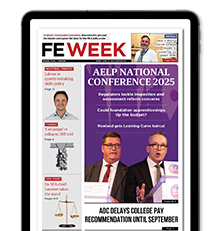FE is often viewed as the less glamorous sibling of Higher Education (HE). But recent shifts in the education landscape suggest FE may be gaining traction as an attractive sector for leaders seeking purpose, clarity, and impact.
Higher Education is navigating one of its toughest periods. Its leaders face immense pressure as institutions grapple with funding challenges and workforce instability. That is combined with the sector’s growing international focus. While rewarding for some, this trend leaves others yearning for a more localised or UK impact. As a result, we’ve seen an increasing number of professionals reevaluating their career paths.
Stability and Security
The recent reclassification of colleges into the public sector has diluted some of the financial volatility that previously plagued FE, although it is still victim to funding changes. While not immune to economic pressures, institutions now benefit from a little more stability and reduced commercial risk. This shift is particularly appealing to leaders in HE who may be weary of constant restructuring and redundancies.
Proximity to HE and the Skills Agenda
The boundaries between HE and FE have never been closer. Regulatory bodies and inspectorates such as the Office for Students and Ofsted are increasingly overlapping in their oversight, particularly as universities expand into apprenticeship provision. This convergence has highlighted the strategic importance of skills development, a core purpose of FE. Boards within colleges are also recognising the value of HE representation, creating opportunities for HE leaders to influence at the board level, as well as considering those with an HE background for senior roles. Greater recognition from HE about the importance of FE representation on their boards would be welcomed.
High Performance and Career Growth
FE institutions are achieving their best-ever Ofsted ratings, reflecting a period of high performance across the sector. Mergers and the growth of college groups have further expanded career pathways and new roles.
These are colleges worth £100 million rather than the low tens. These larger, more complex organisations demand strategic leadership, particularly in areas like corporate services. HR can be transactional in some colleges but needs to be strategic and ensure meaningful workforce planning. For leaders, this represents a chance to shape influential institutions with a regional focus and a strong community purpose.
Larger colleges and groups can also of course offer larger salaries, so attract individuals who wouldn’t have considered FE before.
FE leaders can see the immediate impact of their work
Making a Local Impact
For many leaders, the appeal lies in a localised mission. Unlike universities, which often prioritise global rankings, international students, and international research, colleges focus on transforming their communities, playing the oft-used term ‘anchor institution’ role. FE leaders can see the immediate impact of their work, whether through improving educational outcomes, enhancing society, forging partnerships with local businesses, or addressing skills shortages. This sense of purpose resonates with professionals seeking roles where they can make a tangible difference.
Addressing Barriers: Pay and Recruitment
There are still challenges around pay, with senior roles often offering lower salaries compared to HE that make it difficult to attract permanent candidates.
However, colleges are willing to invest in interim leaders, engaging them on a day-rate basis. This can be financially more beneficial to the interim candidate while reducing add-on costs such as pension contributions to the FE college, allowing them to bridge gaps in expertise. This approach not only attracts high-calibre professionals but also highlights the flexibility and openness of FE institutions to alternative workforce models.
Political and Sectoral Shifts
The political landscape is also influencing perceptions of FE. This Labour government has signalled intent to address the UK’s skills shortage. This drive could bring renewed focus and investment to the sector. Initiatives such as Skills England underscore a commitment to tackling challenges, further enhancing FE’s reputation as a vital component of the education ecosystem. Whether Skills England proves a success or not, only time will tell – but the intent is there.
For those seeking purpose-driven careers, FE provides the chance to lead institutions that are not only high-performing but also deeply rooted in their communities. FE is becoming a more attractive place for leaders ready to make a difference.


















The idiom ‘too many chiefs, not enough indians’ springs to mind.
(This originated in a beautifully written editorial by Hin-mah-too-yah-lat-kekt, known in English as Chief Joseph of the Nez Perces Nation)…
Given that ‘chiefs’ from HE would expect better pay than ‘chiefs’ from FE, that likely means even fewer ‘indians’ or lower pay and living standards.
Eyeing up FE could also be a sign of failure in the higher education system where rampant grade inflation over decades has eroded confidence in the product and that eye watering student loan debt is dampening consumer appetite.
(£236bn in outstanding student loan debt as of March 2024 – or an imaginary stack of pound coins 413,000 miles high, overshooting the the average orbit of moon by around 180,000 miles. Cost versus value is an interesting field of study, in so many ways).
Normally, increased competition for leadership roles (a glut of supply), should lead to lower pay for those roles, unless there are consultants involved of course.
Well I made the move 18 years ago and I have never regretted it. I was previously a deputy head of faculty at a leading Russell Group university. I was struck at the time that many of my erstwhile colleagues regarded it as a backwards career move and a cul de sac.